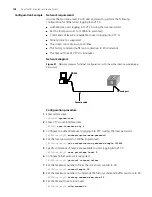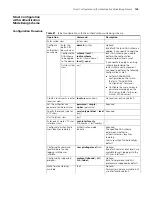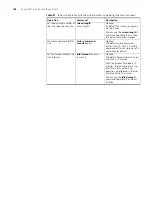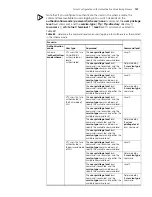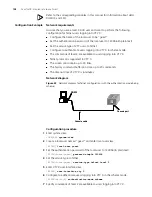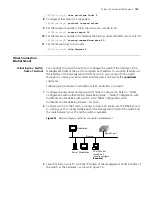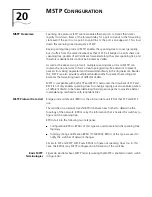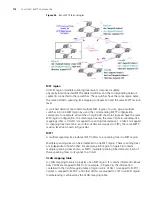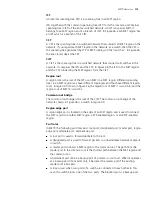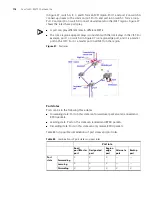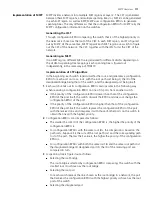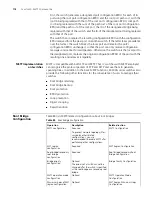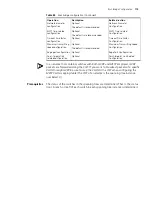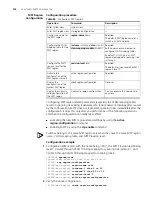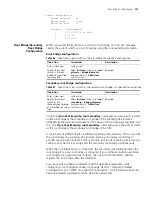
118
C
HAPTER
20: MSTP C
ONFIGURATION
First, the switch generates a designated port configuration BPDU for each of its
port using the root port configuration BPDU and the root port path cost, with the
root ID being replaced with that of the root port configuration BPDU, root path
cost being replaced with the sum of the path cost of the root port configuration
BPDU and the path cost of the root port, the ID of the designated bridge being
replaced with that of the switch, and the ID of the designated port being replaced
with that of the port.
The switch then compares the resulting configuration BPDU with the configuration
BPDU received from the peer port on another switch. If the latter takes precedence
over the former, the switch blocks the local port and remains the port's
configuration BPDU unchanged, so that the port can only receive configuration
messages and cannot forward packets. Otherwise, the switch sets the local port to
the designated port, replaces the original configuration BPDU of the port with the
resulting one and releases it regularly.
MSTP Implementation
on Switches
MSTP is compatible with both STP and RSTP. That is, switches with MSTP employed
can recognize the protocol packets of STP and RSTP and use them to generate
spanning trees. In addition to the basic MSTP functions, S4200G series switches also
provide the following other functions for the convenience of users to manage their
switches.
■
Root bridge retaining
■
Root bridge backup
■
Root protection
■
BPDU protection
■
Loop prevention
■
Digest snooping
■
Rapid transition
Root Bridge
Configuration
Table 84 lists MSTP-related configurations about root bridges.
Table 84
Root bridge configuration
Operation
Description
Related section
MSTP configuration
Required
To prevent network topology jitter
caused by other related
configurations, you are
recommended to enable MSTP after
performing other configurations.
MSTP Configuration
MST region
configuration
Required
MST Region Configuration
Root bridge/secondary
root bridge
configuration
Required
Root Bridge/Secondary Root
Bridge Configuration
Bridge priority
configuration
Optional
The priority of a switch cannot be
changed after the switch is specified
as the root bridge or a secondary root
bridge.
Bridge Priority Configuration
MSTP operation mode
configuration
Optional
MSTP Operation Mode
Configuration
Maximum hops of MST
region configuration
Optional
MST Region Maximum Hops
Configuration
Summary of Contents for 4200G 12-Port
Page 10: ...8 CONTENTS...
Page 14: ...4 ABOUT THIS GUIDE...
Page 46: ...32 CHAPTER 5 LOGGING IN THROUGH WEB BASED NETWORK MANAGEMENT SYSTEM...
Page 48: ...34 CHAPTER 6 LOGGING IN THROUGH NMS...
Page 60: ...46 CHAPTER 9 VLAN CONFIGURATION...
Page 64: ...50 CHAPTER 10 MANAGEMENT VLAN CONFIGURATION...
Page 80: ...66 CHAPTER 13 GVRP CONFIGURATION...
Page 98: ...84 CHAPTER 15 LINK AGGREGATION CONFIGURATION...
Page 112: ...98 CHAPTER 18 MAC ADDRESS TABLE MANAGEMENT...
Page 126: ...112 CHAPTER 19 LOGGING IN THROUGH TELNET...
Page 162: ...148 CHAPTER 20 MSTP CONFIGURATION...
Page 274: ...260 CHAPTER 29 IGMP SNOOPING CONFIGURATION...
Page 276: ...262 CHAPTER 30 ROUTING PORT JOIN TO MULTICAST GROUP CONFIGURATION...
Page 298: ...284 CHAPTER 33 SNMP CONFIGURATION...
Page 304: ...290 CHAPTER 34 RMON CONFIGURATION...
Page 338: ...324 CHAPTER 36 SSH TERMINAL SERVICES...
Page 356: ...342 CHAPTER 38 FTP AND TFTP CONFIGURATION...
Page 365: ...Information Center Configuration Example 351 S4200G terminal logging...
Page 366: ...352 CHAPTER 39 INFORMATION CENTER...
Page 378: ...364 CHAPTER 40 BOOTROM AND HOST SOFTWARE LOADING...
Page 384: ...370 CHAPTER 41 Basic System Configuration and Debugging...
Page 388: ...374 CHAPTER 43 NETWORK CONNECTIVITY TEST...
Page 406: ...392 CHAPTER 45 CONFIGURATION OF NEWLY ADDED CLUSTER FUNCTIONS...

